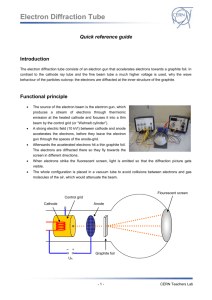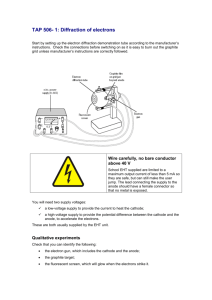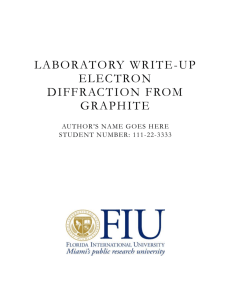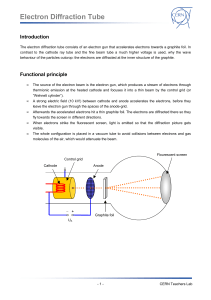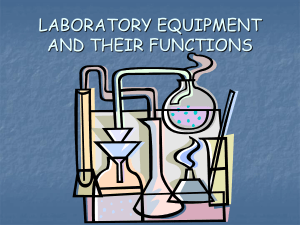Electron Diffraction
advertisement
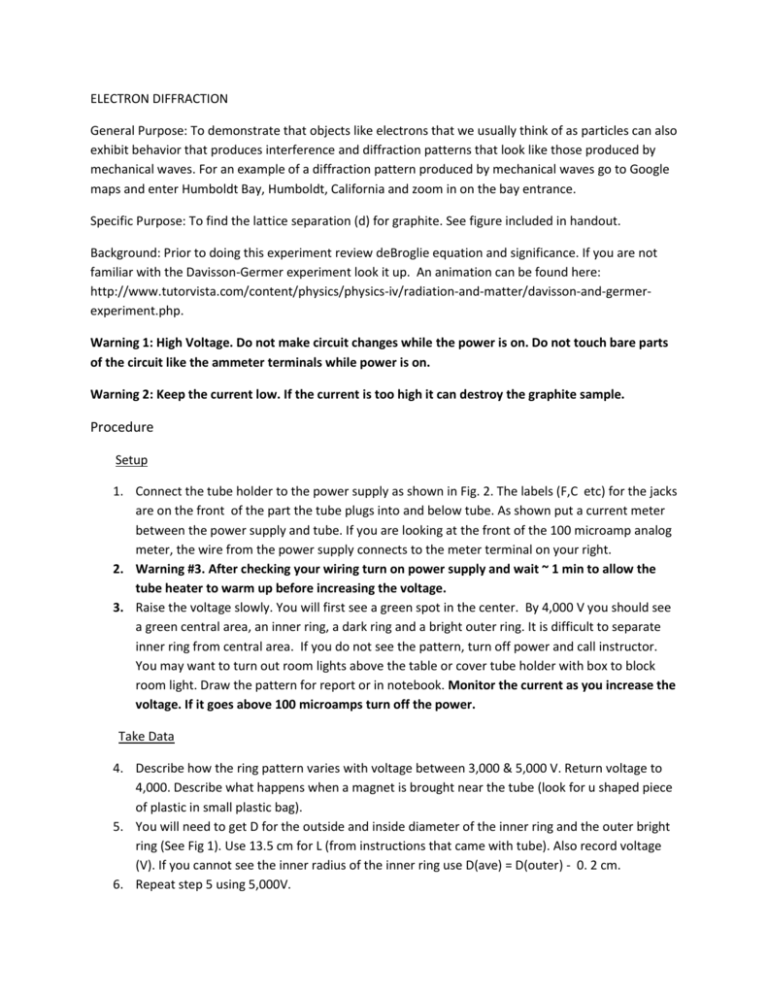
ELECTRON DIFFRACTION General Purpose: To demonstrate that objects like electrons that we usually think of as particles can also exhibit behavior that produces interference and diffraction patterns that look like those produced by mechanical waves. For an example of a diffraction pattern produced by mechanical waves go to Google maps and enter Humboldt Bay, Humboldt, California and zoom in on the bay entrance. Specific Purpose: To find the lattice separation (d) for graphite. See figure included in handout. Background: Prior to doing this experiment review deBroglie equation and significance. If you are not familiar with the Davisson-Germer experiment look it up. An animation can be found here: http://www.tutorvista.com/content/physics/physics-iv/radiation-and-matter/davisson-and-germerexperiment.php. Warning 1: High Voltage. Do not make circuit changes while the power is on. Do not touch bare parts of the circuit like the ammeter terminals while power is on. Warning 2: Keep the current low. If the current is too high it can destroy the graphite sample. Procedure Setup 1. Connect the tube holder to the power supply as shown in Fig. 2. The labels (F,C etc) for the jacks are on the front of the part the tube plugs into and below tube. As shown put a current meter between the power supply and tube. If you are looking at the front of the 100 microamp analog meter, the wire from the power supply connects to the meter terminal on your right. 2. Warning #3. After checking your wiring turn on power supply and wait ~ 1 min to allow the tube heater to warm up before increasing the voltage. 3. Raise the voltage slowly. You will first see a green spot in the center. By 4,000 V you should see a green central area, an inner ring, a dark ring and a bright outer ring. It is difficult to separate inner ring from central area. If you do not see the pattern, turn off power and call instructor. You may want to turn out room lights above the table or cover tube holder with box to block room light. Draw the pattern for report or in notebook. Monitor the current as you increase the voltage. If it goes above 100 microamps turn off the power. Take Data 4. Describe how the ring pattern varies with voltage between 3,000 & 5,000 V. Return voltage to 4,000. Describe what happens when a magnet is brought near the tube (look for u shaped piece of plastic in small plastic bag). 5. You will need to get D for the outside and inside diameter of the inner ring and the outer bright ring (See Fig 1). Use 13.5 cm for L (from instructions that came with tube). Also record voltage (V). If you cannot see the inner radius of the inner ring use D(ave) = D(outer) - 0. 2 cm. 6. Repeat step 5 using 5,000V. 7. Turn the voltage to zero and turn off power supply when finished with measurements. Do not leave on while doing analysis below. Analysis 8. Using the formulae below calculate d, the lattice plane spacing for graphite, for your values of D. Use the average values of D in formulae . Find value of d in meters & nanometers. Think of the front of the tube as part of a circle. There will be some error due to the graphite target not being at the center of the circle. 9. Compare your values of d with those in a book or on Internet. Compute the ratio of larger value of d to smaller value for a given voltage. Ideally the crystal structure would produce a ratio equal to the square root of 2 for a cubic structure and the square root of 3 for a hexagonal structure. Which structure does graphite have? 10. Include this in your report or notebook. Fill in the blanks with particle or wave. a) During acceleration the electron acts like a _______. b) When passing through the graphite target the electron acts like a _______. c) When a magnet is brought near the tube the electron acts like a _______. d) When the electron produces a spot on the phosphor the electron acts like a _______. Sin (2φ) = D/2L (Geometry) λ= h/ (2meV)1/2 (deBroglie in terms of energy) m= mass of electron, e=charge on electron λ = 2d sin(φ) (Bragg relation) Note: The analysis uses the classical (low speed) relation between momentum and kinetic energy. Optional: You may want to look into how the results would be affected if the SR relation between momentum and kinetic energy was used instead.

